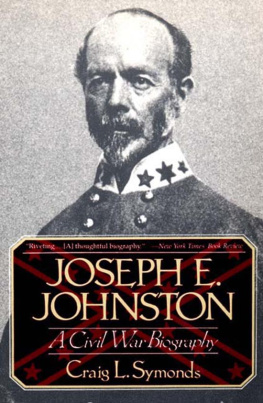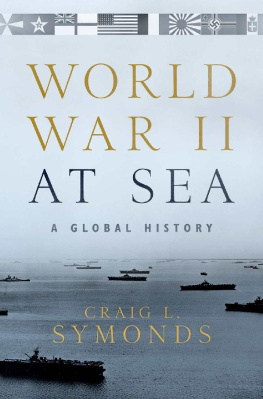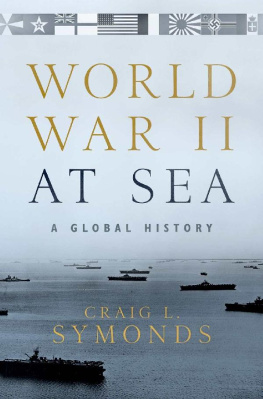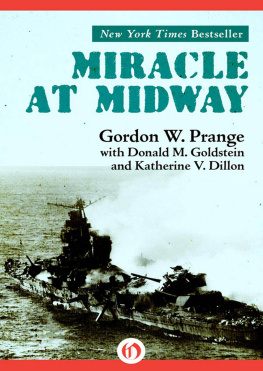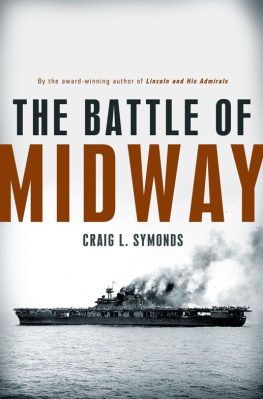Symonds - The Battle of Midway
Here you can read online Symonds - The Battle of Midway full text of the book (entire story) in english for free. Download pdf and epub, get meaning, cover and reviews about this ebook. City: New York;Oxford;Midway Islands, year: 2012;2011, publisher: Oxford University Press, genre: History. Description of the work, (preface) as well as reviews are available. Best literature library LitArk.com created for fans of good reading and offers a wide selection of genres:
Romance novel
Science fiction
Adventure
Detective
Science
History
Home and family
Prose
Art
Politics
Computer
Non-fiction
Religion
Business
Children
Humor
Choose a favorite category and find really read worthwhile books. Enjoy immersion in the world of imagination, feel the emotions of the characters or learn something new for yourself, make an fascinating discovery.

The Battle of Midway: summary, description and annotation
We offer to read an annotation, description, summary or preface (depends on what the author of the book "The Battle of Midway" wrote himself). If you haven't found the necessary information about the book — write in the comments, we will try to find it.
Symonds: author's other books
Who wrote The Battle of Midway? Find out the surname, the name of the author of the book and a list of all author's works by series.
The Battle of Midway — read online for free the complete book (whole text) full work
Below is the text of the book, divided by pages. System saving the place of the last page read, allows you to conveniently read the book "The Battle of Midway" online for free, without having to search again every time where you left off. Put a bookmark, and you can go to the page where you finished reading at any time.
Font size:
Interval:
Bookmark:
THE BATTLE OF MIDWAY
This includes my own own book, Decision at Sea: Five Naval Battles that Shaped American History (New York: Oxford University Press, 2005), which acknowledges that the May 20 intercept was a series of recently intercepted Japanese messages but attributes to them far more specificity than they actually contained (p. 210).
More than fifteen hundred Americans were taken prisoner by the Japanese when the island fell. Most of them (1,146) were civilian construction workers; the others included 368 Marines, 65 Navy men, and five Army soldiers. Most were transported to Japanese POW camps where they remainedthose who surviveduntil 1945. A hundred or so of the construction workers were retained on Wake, and in 1943, when it looked like the island might be recaptured by the Americans, the survivors were lined up and shot.
In fact, these old battleships were too slow to operate with the much faster carrier and cruiser forces and needed significant modification even to fulfill their eventual role as shore bombardment vessels.
Imperial Navy junior officers attempted a coup of their own in May 1932 when a group of them participated in the assassination of Prime Minister Inukai Tsuyoshi. As in 1926, the long-term result was an effort to placate and appease the dissatisfied junior officers.
Initially the Japanese had planned to convert the battle cruiser Amagi into acarrier, but after the Amagi was damaged during a 1923 earthquake, the Japanese were allowed to substitute the even larger battleship Kaga. As shown in the next chapter, the Americans did much the same thing with two battle cruisers that they had under construction that subsequently became the carriers Lexington (CV-2) and Saratoga (CV-3).
.
During 1942, the United States built 47,836 airplanes to Japans 8,861. Over the course of the war, the United States built more than four times as many combat airplanes as Japan: 324,750 to Japans 76,320.
Though the Allied code names for Japanese aircraft did not come into use until 1943, these code names will be used throughout the text for the sake of clarity.
Americas only other carrier at the time was the small converted collier Langley (CV-1). Thirteen steel girders supported a 523-foot-long flight deck some forty feet above her hull, giving her the appearance of a long building with a flat roof and no walls. This gave rise to her nickname, The Old Covered Wagon. In 1937, she was converted into a seaplane tender (AV-3).
Grumman claimed that the F4F-4 could climb at a modest but respectable 1,950 feet per minute, but in combat conditions, pilots complained their Dash 4s could ascend only at about 1,000 feet per minute.
The Ranger was the first U.S. Navy warship to be built from the keel up as a carrier, but her designers conceived of her as a way to provide air cover for the battle fleet rather than as an independent strike platform. As a result, she lacked both armor and internal watertight integrity. A single bomb could sink her. Thus she was kept in the Atlantic, where she subsequently provided air cover for the landings in North Africa.
Halsey noted Gaidos heroic effort and promoted him to aviation mate first class that afternoon.
There was another reason why the Western allies worried so much about Australia. As King wrote to FDR on March 5: Australiaand New Zealandare white mens countries which it is essential that we shall not allow to be overrun by Japanese because of the repercussion among the non-white races of the world.
Recognizing the public relations value of OHares feat, the Navy ordered him stateside, where Roosevelt awarded him the Medal of Honor, after which he was sent on a tour to sell war bonds. For that reason, he missed both the Battle of the Coral Sea and Midway.
Few of the thousands of modern-day passengers who travel through Chicago are aware that the citys two major airports are both named to honor heroes of the Pacific War. Midway Airport is named for the battle itself, and passengers there can view a full-sized Dauntless dive bomber suspended from the ceiling of Terminal A. The larger OHare Airport, one of the busiest in the world, is named for Butch OHare.
This is not to be confused with the Australia-New Zealand Army Corps, also called ANZAC, which fought at Gallipoli in World War I. This new ANZAC command lasted only until April, when it was absorbed into the Southwest Pacific command under Douglas MacArthur.
Early in 1941, Yamamoto wrote a letter to another officer who favored war with America. In that letter, Yamamoto stated that in any such war the Japanese would be compelled to seek a capitulation at the White House, in Washington itself. After the war began, Japanese newspapers published this letter, which led the Western press to assume that this was, in fact, Yamamotos goal. Instead, Yamamoto had written the letter as a way of suggesting that a war with the U.S. was not winnable. The next line in this letter, omitted when it was published, was: I wonder whether the politicians of the day really have the willingness to make [the] sacrifice that this would entail.
Dwight Morrow, a former Republican senator from Ohio, had a special interest in aviation. (His daughter Anne would later marry the famed aviator Charles Lindbergh.) It was the Morrow Board that recommended the creation of a separate Air Corps within the U.S. Army.
The Army pilots were Lieutenants John Fitzgerald and James McCarthy, the first men to fly land-based bombers off a carrier deck, and they did so with no special training and very little advance notice.
Very likely, Captain Yorks plane burned fuel faster than the others because the mechanics at McClellan Field near Sacramento, unaware that the carburetors on the Mitchell bombers had been specially recalibrated for fuel economy, reset them to normal.
The on-the-roof gang got its name from the fact that the men were trained on the roof of the Navy Department Building in Washington on which the radio intercept tower was located. Because the building had not been designed for such use, the trainees had to climb a ladder to get there.
The term Hypo (the British phonetic code for the letter H) derived not from its location in Hawaii or Honolulu but from the radio tower at Heeia. Hypo was later redesignated as the Fleet Radio Unit, Pacific (FRUPAC). Station Cast was named for Cavite Navy Yard in Manila and later moved to Corregidor when the Japanese overran Manila. Eventually it relocated to Melbourne, Australia, where it was renamed Belconnen, and later Fleet Radio Unit, Melbourne (FRUMEL).
In the interest of accuracy, not to mention fairness, it is important to note that one of the prime movers of this early organization was Agnes Miss Aggie Driscoll, who began working in the Code and Signal Station when Safford did in 1924. She held the rank of chief yeoman (the highest then available to women), though she all but invented the science of cryptanalysis and trained most of the men who later played such a crucial role in American code breaking.
That same day, the Japanese changed their code system for geographical designators. They often did this just prior to a new operation to ensure secrecy. This time, however, their decision backfired, since the change helped confirm the imminent attack, and the message contained both the old and new designators, which allowed the code breakers to update their dictionary of designators.
Some historians have criticized this decision, pointing out that had Fletcher won the carrier battle, the Japanese would have had to call off Operation MO, and had he lost it, Craces few cruisers and destroyers would not have been strong enough to stop them anyway, so that Fletchers decision simply took Craces surface force off the battle map. But Crace himself sought an independent role in the campaign, and, as it happened, he had a completely unforeseen role to play.
Next pageFont size:
Interval:
Bookmark:
Similar books «The Battle of Midway»
Look at similar books to The Battle of Midway. We have selected literature similar in name and meaning in the hope of providing readers with more options to find new, interesting, not yet read works.
Discussion, reviews of the book The Battle of Midway and just readers' own opinions. Leave your comments, write what you think about the work, its meaning or the main characters. Specify what exactly you liked and what you didn't like, and why you think so.

